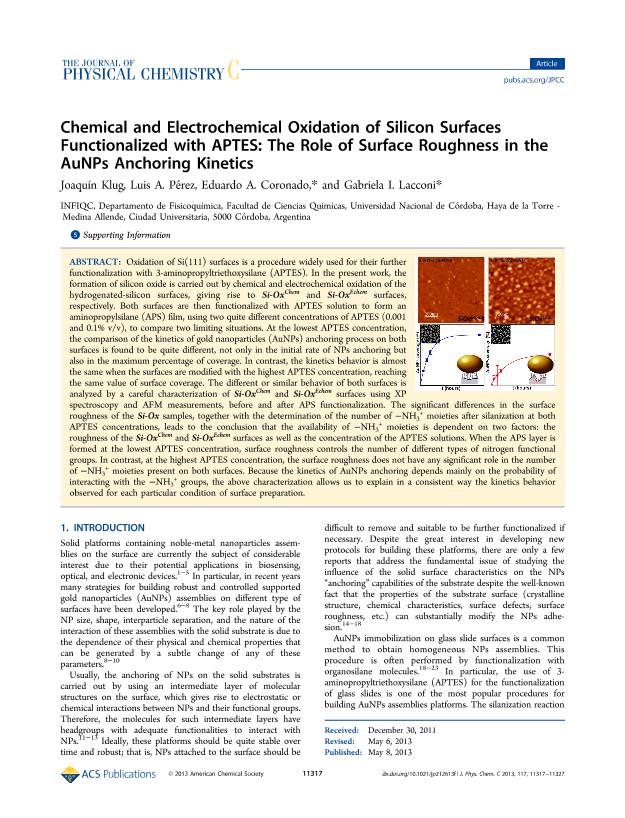Artículo
Chemical and electrochemical oxidation of silicon surfaces functionalized with APTES: the role of surface roughness in the AuNPs anchoring kinetics
Fecha de publicación:
05/2013
Editorial:
American Chemical Society
Revista:
Journal of Physical Chemistry C
ISSN:
1932-7447
Idioma:
Inglés
Tipo de recurso:
Artículo publicado
Clasificación temática:
Resumen
Oxidation of Si(111) surfaces is a procedure widely used for their further functionalization with 3-aminopropyltriethoxysilane (APTES). In the present work, the formation of silicon oxide is carried out by chemical and electrochemical oxidation of the hydrogenated-silicon surfaces, giving rise to Si-OxChem and Si-OxEchem surfaces, respectively. Both surfaces are then functionalized with APTES solution to form an aminopropylsilane (APS) film, using two quite different concentrations of APTES (0.001 and 0.1% v/v), to compare two limiting situations. At the lowest APTES concentration, the comparison of the kinetics of gold nanoparticles (AuNPs) anchoring process on both surfaces is found to be quite different, not only in the initial rate of NPs anchoring but also in the maximum percentage of coverage. In contrast, the kinetics behavior is almost the same when the surfaces are modified with the highest APTES concentration, reaching the same value of surface coverage. The different or similar behavior of both surfaces is analyzed by a careful characterization of Si-OxChem and Si-OxEchem surfaces using XP spectroscopy and AFM measurements, before and after APS functionalization. The significant differences in the surface roughness of the Si-Ox samples, together with the determination of the number of −NH3 + moieties after silanization at both APTES concentrations, leads to the conclusion that the availability of −NH3 + moieties is dependent on two factors: the roughness of the Si-OxChem and Si-OxEchem surfaces as well as the concentration of the APTES solutions. When the APS layer is formed at the lowest APTES concentration, surface roughness controls the number of different types of nitrogen functional groups. In contrast, at the highest APTES concentration, the surface roughness does not have any significant role in the number of −NH3 + moieties present on both surfaces. Because the kinetics of AuNPs anchoring depends mainly on the probability of interacting with the −NH3 + groups, the above characterization allows us to explain in a consistent way the kinetics behavior observed for each particular condition of surface preparation.
Archivos asociados
Licencia
Identificadores
Colecciones
Articulos(INFIQC)
Articulos de INST.DE INVESTIGACIONES EN FISICO- QUIMICA DE CORDOBA
Articulos de INST.DE INVESTIGACIONES EN FISICO- QUIMICA DE CORDOBA
Citación
Klug, Joaquín; Pérez, Luis Alberto; Coronado, Eduardo A.; Lacconi, Gabriela Ines; Chemical and electrochemical oxidation of silicon surfaces functionalized with APTES: the role of surface roughness in the AuNPs anchoring kinetics; American Chemical Society; Journal of Physical Chemistry C; 117; 21; 5-2013; 11317-11327
Compartir
Altmétricas




